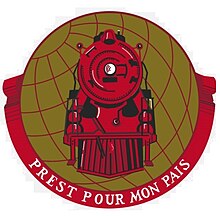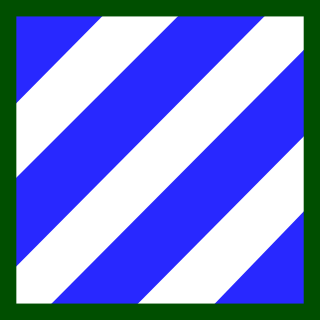
The 3rd Infantry Division (3ID) is a combined arms division of the United States Army based at Fort Stewart, Georgia. It is a subordinate unit of the XVIII Airborne Corps under U.S. Army Forces Command. Its current organization includes a division headquarters and headquarters battalion, two armored brigade combat teams, one aviation brigade, a division artillery, a sustainment brigade and a combat sustainment support battalion along with a maneuver enhancement brigade. The division has a distinguished history, having seen active service in World War I, World War II, the Korean War, and the Global War on Terror. The Medal of Honor has been awarded to 61 members of the 3rd Infantry Division, making the division the most honored in the Army.

The Chicago, Burlington and Quincy Railroad was a railroad that operated in the Midwestern United States. Commonly referred to as the Burlington Route, the Burlington, CB&Q, or as the Q, it operated extensive trackage in the states of Colorado, Illinois, Iowa, Missouri, Nebraska, Wisconsin, Wyoming, and also in Texas through subsidiaries Colorado and Southern Railway, Fort Worth and Denver Railway, and Burlington-Rock Island Railroad. Its primary connections included Chicago, Minneapolis–Saint Paul, St. Louis, Kansas City, and Denver. Because of this extensive trackage in the midwest and mountain states, the railroad used the advertising slogans "Everywhere West", "Way of the Zephyrs", and "The Way West".

A long-range reconnaissance patrol, or LRRP, is a small, well-armed reconnaissance team that patrols deep in enemy-held territory.

The 80th Training Command is a formation of the United States Army Reserve.

The 3rd United States Infantry Regiment is a regiment of the United States Army. It currently has three active battalions, and is readily identified by its nickname, The Old Guard, as well as Escort to the President. The regimental motto is Noli Me Tangere. The regiment is a major unit of the Military District of Washington (MDW). The 3rd Infantry is the oldest regiment still active in the Regular Army, having been first organized as the First American Regiment in 1784. It has been the official ceremonial unit of the U.S. Army since 1948.

The 9th Infantry Regiment ("Manchu") is a parent infantry regiment of the United States Army.

The 9th Cavalry Regiment is a parent cavalry regiment of the United States Army. Historically, it was one of the Army's four segregated African-American regiments and was part of what was known as the Buffalo Soldiers. The regiment saw combat during the Indian and Spanish–American Wars. During Westward Expansion, the regiment provided escort for the early western settlers and maintained peace on the American frontier.
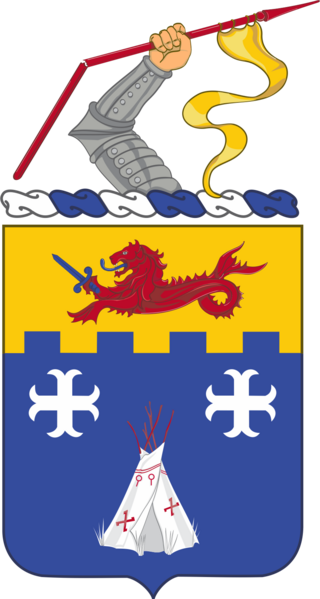
The 12th Infantry Regiment is a unit of the United States Army. The 12th Infantry has fought in seven wars from the Civil War to the War in Afghanistan (2001-2021) and has been awarded 19 Presidential Unit Citations, five Valorous Unit Awards, a Joint Meritorious Unit Award, two citations in the Order of the Day of the Belgian Army, Nine Republic of Vietnam Crosses of Gallantry, the Republic of Vietnam Civil Action Honor Medal Third Class, a Meritorious Unit Commendation, and the Belgian Fourragere.

The 14th Infantry Regiment is a United States Army light infantry regiment. It has served in the American Civil War, Boxer Rebellion, World War II, Korean War, Vietnam War, Operation Restore Hope, Operation Uphold Democracy, Operation Joint Guard, Operation Desert Storm, Operation Enduring Freedom, Operation Gothic Serpent, Operation New Dawn, Operation Resolute Support,Operation Iraqi Freedom, and Operation Inherent Resolve. The 14th Infantry Regiment did not take part in combat during World War I. It has also conducted peacekeeping and humanitarian missions in the Sinai Peninsula, Guantánamo Bay in Cuba, Bosnia, and Kosovo.

Camp Taji, also known as Camp Cooke, is a military installation used by Iraqi and Coalition forces near Taji, Baghdad Governorate, Iraq. The camp is located in a rural region approximately 27 km (17 mi) north of the capital Baghdad.

The EMD MRS-1 is a type of diesel-electric locomotive built by General Motors Electro-Motive Division for the United States Army Transportation Corps (USATC) in 1952. They were built with multigauge trucks and to a narrow loading gauge for service anywhere in the world in the event of war. Thirteen of the locomotives were built, with serial numbers 15873–15885. At almost $500,000 each in 1952 dollars, more than three times the price of a standard locomotive of the period, these were very expensive locomotives.

The Fort Eustis Military Railroad is an intra-plant United States Army rail transportation system existing entirely within the post boundaries of the United States Army Transportation Center and Fort Eustis (USATCFE), Fort Eustis, Virginia. It has served to provide railroad operation and maintenance training to the US Army and to carry out selected material movement missions both within the post and in interchange with the US national railroad system via a junction at Lee Hall, Virginia. It consists of 31 miles (50 km) of track broken into three subdivisions with numerous sidings, spurs, stations and facilities.

The ALCO MRS-1 is a type of diesel-electric locomotive built by the American Locomotive Company for the United States Army Transportation Corps. They were built with multigauge trucks and to a reduced loading gauge for service anywhere in the world in the event of war.
Forward Operating Base Iskandariyah (Arabic:إسكندرية), or FOB Iskandariyah, was a United States military forward operating base located on the grounds of the Musayyib Power Plant and the banks of the Euphrates River, north of the town of Musayyib, Babil Governorate, Iraq from 2003 to 2009.
The 64th Armor Regiment is an armor regiment of the United States Army, organized under the United States Army Regimental System. It is descended from the 758th Tank Battalion (Light) that served in the Italian campaign during World War II. Redesignated as the 64th Tank Battalion, it was assigned to the 3rd Infantry Division during the Korean War and it spent most of the Cold War stationed in West Germany before elements were transferred to Ft. Stewart, Georgia in the late 1990s. The regiment participated in Desert Shield, Desert Storm, Desert Fox, Desert Spring, Operation Iraqi Freedom and Operation Enduring Freedom.
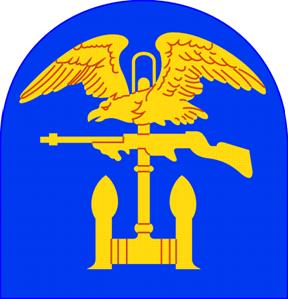
The Engineer Special Brigades were brigade-sized amphibious forces of the United States Army developed during World War II and active from 1942 to 1955. Initially designated engineer amphibian brigades, they were redesignated engineer special brigades in 1943. The 1st, 5th, and 6th Engineer Special Brigades were assigned to the European Theater of Operations. The 1st Engineer Special Brigade participated in the landings in Sicily and Italy before joining the 5th and 6th Engineer Special Brigades for the invasion of Normandy.
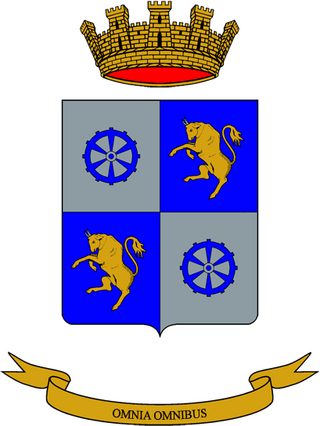
The Logistic Regiment "Taurinense" is a military logistics regiment of the Italian Army based in Rivoli in Piedmont. Originally a transport unit, the regiment is now the logistic unit of the Alpine Brigade "Taurinense" and shares with the brigade's infantry troops, the Alpini, the distinctive Cappello Alpino. The regimental anniversary falls, as for all units of the Transport and Materiel Corps, on 22 May, the anniversary of the Italian Army's first major automobile use to transport reinforcements to counter the Austro-Hungarian Offensive at Asiago in 1916.

The Ferrovieri Engineer Regiment is a military engineer regiment of the Italian Army based in Castel Maggiore in the Emilia Romagna. Today the regiment is assigned to the army's Engineer Command and is NATO's only unit capable of railway construction and operation. The term "Ferrovieri" comes from the Italian word for railway and is used to denote units of the engineer arm tasked with the construction, restoration, maintenance, and operation of railways. Enlisted personnel in such units are addressed by the singular form: "Ferroviere".

Clarence Lamar Burpee was a United States Army general who commanded the 2nd Military Railway Service during World War II.
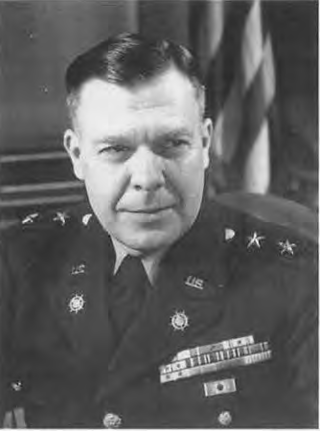
Paul Frailey Yount was a United States Army general who served in World War II and the Korean War. He was the Chief of the United States Army Transportation Corps from 1954 to 1958.
